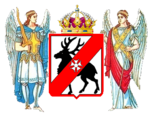Coat of arms of Nidaros
| The lesser coat of arms of Nidaros | |
 | |
| Details | |
|---|---|
| Armiger | The King of Nidaros |
| Adopted | 1519 |
| Escutcheon | Argent, a stag sable trippant, over all a bend gules charged with an eight-pointed star argent |
The coat of arms of Nidaros is the official heraldic symbol representing the Kingdom of Nidaros, one of the three constituent kingdoms of the Three Kingdoms of Nidaros, Riskai, and Celebarad. This emblem reflects Nidaros's historical sovereignty, cultural heritage, and its integral role within the united kingdoms.
Design
The coat of arms of Nidaros features a silver shield (argent) with a striking black stag (sable) in a dynamic, advancing posture. A bold red diagonal band (a bend gules) crosses the shield from the upper left to the lower right. Centred on the red band is a white eight-pointed star, adding a prominent focal point to the design. The shield is crowned with a royal crown, symbolizing the kingdom's sovereignty.
Flanking the shield are two angelic figures serving as supporters. The angel on the left is clad in blue armour and carries a golden sword, symbolizing protection and divine authority. The angel on the right is dressed in red and white robes and holds a golden sceptre, representing wisdom and governance.
Symbolism
Each element of the Nidaros coat of arms carries significant meaning rooted in the kingdom’s history and identity:
- The Black Stag (Sable): The stag symbolizes strength, resilience, and the untamed wilderness that characterizes much of Nidaros's landscape. It also reflects ancient hunting traditions and the noble virtues of vigilance and leadership.
- The Red Border and Diagonal Band (A bordure gules; a bend gules): This bold red stripe represents martial strength, valor, and the kingdom’s historical role in defending its sovereignty.
- The White Eight-Pointed Star (argent): The star is a symbol of guidance, purity, and divine protection. It also reflects Nidaros’s spiritual heritage, particularly its historical importance as a religious center.
- The Royal Crown: Placed atop the shield, the crown signifies the monarchy of Nidaros and its longstanding royal lineage.
- The Angelic Supporters: These figures symbolize divine guardianship and justice. The armed angel reflects protection and strength, while the robed angel signifies wisdom and peace.
History
The coat of arms was adopted by King Karl Gustav in 1519.
Usage
The coat of arms of Nidaros is used extensively in official state functions, royal ceremonies, and government insignia. It appears on state documents, coins, military standards, and architectural landmarks throughout the kingdom. The emblem is also present in the regalia of the monarch and various noble houses.
The angelic supporters are primarily featured in formal and ceremonial versions of the arms, while simplified versions often display only the shield and crown.
The lesser version of the arms (only the shield) is used by the civil authorities while the greater version by the King and those with royal licence of usage.
